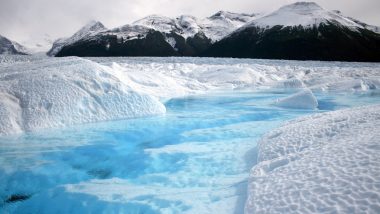The Thwaites Glacier, often referred as the Doomsday Glacier is an unusually broad and fast Antarctic glacier flowing into the Pine Island Bay, which is part of Amundsen Sea, east of Mount Murphy, on the Walgreen Coast of Marie Byrd Land. The Thwaites Glacier is closely watched for its potential to raise sea levels. Climate scientists regard Thwaites Glacier as one of the most vulnerable and most significant glaciers in the world, when it comes to future global sea-level rise. Now, scientists warn of the rapid melting of ice of the doomsday glacier, threatening catastrophic sea-level rise. Its collapse could lead to rapid sea-level rise, the ramifications for most countries, including coastal cities, would be devastating. Hidden Mountain Valleys Discovered Under Ice in Antarctica.
Earlier this year, a team of scientists, for the first time, observed the presence of warm water at a vital point underneath the glacier, which helps explain the reason behind the extent of its decrease. The reason the Thwaites Glacier in Antarctica is described as the ‘doomsday glacier,’ because of the catastrophe, it could potentially create through a rapid rise in sea-level, following rapid melting in ice. Even now, ice draining from the glacier into the Amundsen Sea reportedly accounts for about 4% of global sea-level rise. It quickly becomes unstable, as per the latest observation, and scientists fear that it could collapse. Massive Iceberg More Than 600-Square-Mile Size Breaks Off Antarctica But Climate Change is Not The Culprit.
Paul Cutler, programme director for Antarctic glaciology at America’s National Science Foundation was quoted explained the Financial Times saying, “The big question is how quickly it becomes unstable. It seems to be teetering at the edge.” He added, “It is a keystone for the other glaciers around it in West Antarctica. If you remove it, other ice will potentially start draining into the ocean too.” Cutler explained that Thwaites Glacier is losing ice faster and faster, and the process seems to be accelerating.
The latest warning over Antarctica’s melting glaciers comes during a record heatwave on the other side of the planet in the Arctic. Both the Antarctic and Arctic regions are warming faster than the rest of the world. The high temperatures have also fuelled wildfires. Antarctica accounts for vast quantities of ice—around 90 percent of all ice in the world, and most of the ice is out of the water and on land. The Thwaites glacier in the region is about 74,000 square miles, roughly the size of the UK. Over the past 30 years, the amount of ice flowing out of Thwaites and its neighbouring glaciers has been doubled.
(The above story first appeared on LatestLY on Jul 14, 2020 02:02 PM IST. For more news and updates on politics, world, sports, entertainment and lifestyle, log on to our website latestly.com).













 Quickly
Quickly












